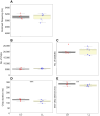Light alters calling-song characteristics in crickets
- PMID: 39876823
- PMCID: PMC11928050
- DOI: 10.1242/jeb.249404
Light alters calling-song characteristics in crickets
Abstract
Communication is crucial for mate choice and thus for the survival and fitness of most species. In the cricket, females choose males according to their calling-song attractiveness and, exhibiting positive phonotaxis, they approach the chosen male. Light has been widely reported to induce changes in crickets' daily activity patterns, including the males' stridulation behavior. It had remained unknown, however, whether light also affects the calling-song properties and thus may consequently also alter female choice. Here, we present a novel semi-automated process, enabling the analysis of calling-song properties in an extremely large sample size of recording sections from males subjected to lifelong light:dark (LD) or constant light (LL) conditions. Our findings revealed that the LD calling songs consisted of longer chirps, longer inter-syllable intervals and a higher proportion of 4-syllable chirps compared with those of LL males. We also conducted some preliminary female choice experiments suggesting that females (reared in LD conditions) exposed to playbacks of male calling songs exhibit a preference towards LD over LL recordings. We therefore conclude that illumination conditions such as constant light affect the male crickets' calling-song properties in a manner that may be discernible to the females. It remains unclear, however, how and to what extent female mate choice and the species' overall fitness are affected by these changes.
Keywords: Gryllus bimaculatus; Bioacoustics; Computational analysis; Intraspecific communication; Sexual selection; Stridulation.
© 2025. Published by The Company of Biologists.
Conflict of interest statement
Competing interests The authors declare no competing or financial interests.
Figures






References
-
- Alexander, R. D. (1960). Sound communication in Orthoptera and Cicadidae. Anim. Sounds Commun 1, 38-92.
-
- Beckers, O. M. (2020). Phenotypic plasticity related to temperature induces song variation in the field cricket Gryllus rubens. Ethology 126, 781-790. 10.1111/eth.13035 - DOI
-
- Beckers, O. M., Murphey, K. J., Pease, J. R. and Norman, N. (2019). Parallel plasticity of mating songs and preferences in the field cricket Gryllus rubens. Ethology 125, 476-484. 10.1111/eth.12872 - DOI
-
- Bent, A. and Hedwig, B. (2023). Phonotaxis of male field crickets, Gryllus bimaculatus, to conspecific calling song. Anim. Behav. 205, 173-181. 10.1016/j.anbehav.2023.08.010 - DOI
Publication types
MeSH terms
Grants and funding
LinkOut - more resources
Full Text Sources
Research Materials

